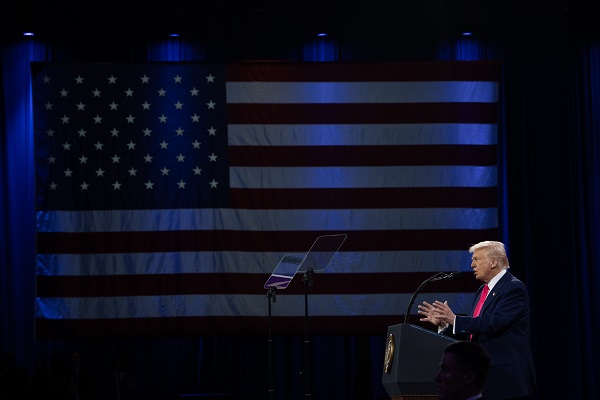Gerry Feehan
Sailing the Nile – Parts 1 and 2
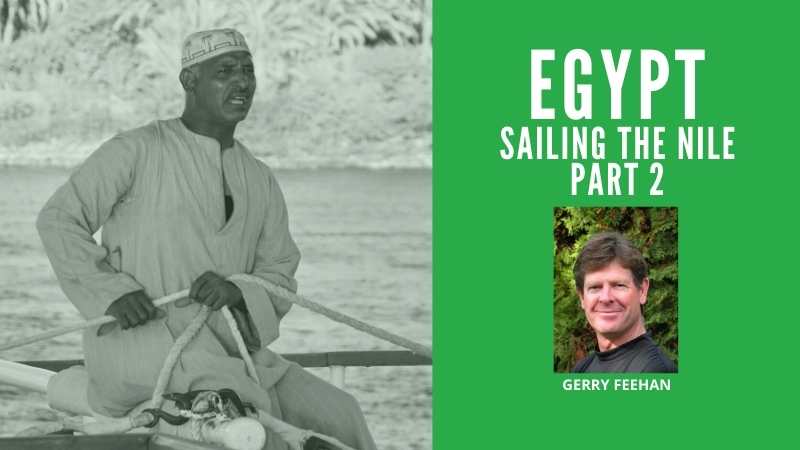
Sailing the Nile
This is the second in a two-part series “Sailing the Nile”.
There were only 15 guests on board the Malouka: nine polite Americans and our group of six raucous Canadians. We were on a six-day sail up the Nile River. The vessel was a traditional double-masted dahabiya, part of the Nour el Nil fleet https://www.nourelnil.com/
Dahabiyas have been plying the waters of the Nile for millennia. But this was a cleverly-constructed, modern, luxurious craft for us clever, modern, luxuriant folk.
In addition to the crew – who outnumbered the guests – we were graced with the presence of Jean-Pierre, a gentle man with a charming Parisian accent whose only responsibility aboard ship (from what we could glean) was to hop from boat to boat, entertaining the guests with his relaxed septuagenarian spirit – and to act as self-appointed ‘bodyguard’ to Eleanor, one of the fleet’s owners. Eleanor, an elegant French lady, maintained her sumptuous quarters on the Malouka’s sister ship, the Meroe.
Every meal, breakfast, lunch and dinner, was served in style, on deck, in the open air. The food was amazing. We were waited on like Pharaohs and Queens: fresh-netted Nile perch, crisp fried falafel and baba ghanouj; straight-from–the-oven flatbread to scoop up the tahini, hummus and yogurt sauces. Each afternoon, we were offered the refreshing juice of some exotic fruit. After dinner, often just a simple desert of dates and figs.

After feeding the guests, the crew enjoys lunch on the lower deck
We quickly bonded with the crew. Where English/Arabic language issues arose, the occasional knowing nod, some common courtesy and a mutual admiration for the beauty of the Nile, sufficed. The Egyptian crew was polite and attentive. And even the most hardened of these river seamen displayed a boyish sense of humour.
Each time we neared shore to dock for an excursion, the captain – whom the staff had inexplicably nicknamed Humpty Dumpty – commenced a routine of alarmed shouts directed at the bow crew—while simultaneously engaging in a frantic arm-waving ceremony toward the helmsman. As we neared Edfu, and before he could start this inevitable daily performance, I jumped into his station at the bow and began gesticulating and yelling in my best pidgin Arabic.
Humpty looked at me in astonishment. The crew was momentarily dumfounded. Then one-by-one they burst into hysterical laughter. The cook, abandoning the galley, fell to the floor, pounding his fists on the deck with unrestrained glee.
I looked at the captain apologetically and said, “Asif.” But I wasn’t really sorry—and Humpty was laughing just as hard as the others.
The sun began to redden over the Nile. The barge passed fertile fields of cotton and sugar cane; lush orchards of pomegranates and figs. Galabiya-clad shepherds looked up from their flocks. Women washed clothes in the fading light. Children leapt into the clear warm water. A startled grey heron squawked. A young boy astride a thin donkey waived hello. Everything was fun and games. Then the squall hit.
The sudden gale propelled the dahabiya sideways. We were headed for an inevitable collision with shore. All hands were on deck as the bow slowly crushed into a thick grove of papyrus. I looked at the captain. He was not laughing. Orders were shouted. Two crewmen jumped overboard with tie-lines in hand, frantically swimming through the thick reeds. On shore they pounded grounding stakes into the hard bank. Then the entire team, from first mate to cook, hauled fast the lines.
When you are a ship’s captain you are on duty 24/7 and can never break, even if your name is Humpty.
As quickly as it started the squall ebbed and all was well again.

Humpty at the helm

This motley crew was not much help during the squall
After the calm we resumed our drift. Near the Temple of Horemheb we tied up for the night, went ashore and visited a small village. We popped in for shai (tea) at what can only be described as the neighbourhood pub, although no alcohol was served. The place smelled of desert grime seasoned with stale tobacco smoke. In the dim murky light an animated group of men were huddled around a table, taking turns smashing domino tiles down upon the battered old piece of furniture. They offered us shai and thick, sweet Turkish coffee, then invited us to join the game and share shisha—a water pipe. The local tobacco is flavoured with fruit and the taste is very mild. Even a deep inhale doesn’t burn the lungs. Or so I’m told.
It was evident that the people here were desperately poor. And yet they welcomed us politely, with expressions of sincere gratitude for our visit to their country. Proffered payment for the shai, coffee, shisha—and our domino debts—were all firmly refused.

Young and old, Nile folk were friendly and welcoming

Egypt needs visitors. Tourism has been hard hit by an unfortunate series of events: 9/11, middle-east concerns, terrorist threats – both real and imagined. The 2010 ‘Arab Spring’ democratic uprising was, ironically, particularly devastating. Tourist numbers plummeted to near zero, but are now recovering. Still, only about 150 of the 350 tour boats that formerly plied this section of the Nile are operating.
We left the village and climbed to a high vantage point overlooking the mighty river. It began to rain. Soon we were all soaked to the skin. Sawi, Alberto and Mahmoud (our on-board waiters and off-board protectors) danced gleefully in the desert downpour. This part of Egypt had not seen rain for four years.
In the morning, docked below the high dam at Aswan, we enjoyed a solemn breakfast while watching a last sunrise over the Nile. Our toast was served with marmalade and melancholy. Our time aboard the Melouka was over. Jean-Pierre and Eleanor came to bid us adieu. All of the crew were emotional. Mahmoud’s eyes were glued to the floor. You know I hate to see a grown man cry… so I avoided looking in the mirror.
We walked the gangplank off the dahabiya. A van awaited us dockside. There we were introduced to Sayed Mansour, from Exodus Travel, who would be our guide for the rest of our Egyptian adventure. He hurried us into the van. A plane awaited us. We were bound for the ancient temple of Abu Simbel on Lake Nasser.
Exodus Travel skillfully handled every detail of our Egypt adventure: www.exodustravels.com/
Gerry Feehan is an award-winning travel writer and photographer. He lives in Kimberley, BC.
 Gerry Feehan is an award-winning travel writer and photographer. He and his wife Florence now live in Kimberley, BC!
Gerry Feehan is an award-winning travel writer and photographer. He and his wife Florence now live in Kimberley, BC!
Thanks to Kennedy Wealth Management and Ing and McKee Insurance for sponsoring this series. Click on their ads and learn more about these long-term local businesses.
Click to read more travel stories.
8 miles off the coast of Ireland Gerry Feehan’s “Buddy-Hike” discovers the Skellig Islands
Gerry Feehan
Abu Simbel
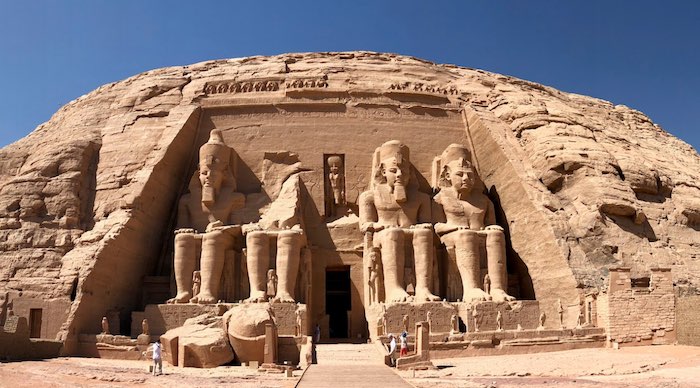
Abu Simbel is a marvel of ancient and modern engineering
I love looking out the window of an airplane at the earth far below, seeing where coast meets water or observing the eroded remains of some ancient formation in the changing light. Alas, the grimy desert sand hadn’t been cleaned from the windows of our EgyptAir jet, so we couldn’t see a thing as we flew over Lake Nasser en route to Abu Simbel. I was hopeful that this lack of attention to detail would not extend to other minor maintenance items, such as ensuring the cabin was pressurized or the fuel tank full.
We had just spent a week on a dahabiya sailboat cruising the Nile River, and after disembarking at Aswan, were headed further south to see one of Egypt’s great
monuments. There are a couple of ways to get to Abu Simbel from Aswan. You can ride a bus for 4 hours through the scorched Sahara Desert, or you can take a plane for the short 45-minute flight.
Opaque windows notwithstanding, I was glad we had chosen travel by air. Abu Simbel is spectacular, but there’s really not much to see except the monument itself and a small adjacent museum. So most tourists, us included, make the return trip in a day. And fortunately we had Sayed Mansour, an Egyptologist, on board. Sayed was there to explain all and clear our pained expressions.
Although it was early November, the intense Nubian sun was almost directly overhead, so Sayed led us to a quiet, shady spot where he began our introduction to
Egyptian history. Abu Simbel is a marvel of engineering — both modern and ancient. The temples were constructed during the reign of Ramses II. Carved from solid rock in a sandstone cliff overlooking the mighty river, these massive twin temples stood sentinel at a menacing bend in the Nile — and served as an intimidating obstacle to would-be invaders — for over 3000 years. But eventually Abu Simbel fell into disuse and succumbed to the inevitable, unrelenting Sahara. The site was nearly swallowed by sand when it was “rediscovered” by European adventurers in the early 19 th century. After years of excavation and restoration, the monuments resumed their original glory.
Then, in the 1960’s, Egyptian president Abdel Nasser decided to construct a new “High Dam” at Aswan. Doing so would create the largest man-made lake in the
world, 5250 sq km of backed-up Nile River. This ambitious project would bring economic benefit to parched Egypt, control the unpredictable annual Nile flood and also supply hydroelectric power to a poor, under-developed country. With the dam, the lights would go on in most Egyptian villages for the first time. But there were also a couple of drawbacks, which were conveniently swept under the water carpet by the government. The new reservoir would displace the local Nubian population whose forbearers had farmed the fertile banks of the Nile River for millennia. And many of Egypt’s greatest monuments and tombs would be forever submerged beneath the deep new basin — Abu Simbel included. But the government proceeded with the dam, monuments be damned.
Only after the water began to rise did an international team of archaeologists, scientists — and an army of labourers — begin the process of preserving these
colossal wonders. In an urgent race against the rising tide, the temples of Abu Simbel were surgically sliced into gigantic pieces, transported up the bank to safety and reassembled. The process was remarkable, a feat of engineering genius. And today the twin edifices, honouring Ramses and his wife Nefertari remain, gigantic, imperious and intact. But instead of overlooking a daunting corner of the Nile, this UNESCO World Heritage site now stands guard over a vast shimmering lake.
Sayed led us into the courtyard from our shady refuge and pointed to the four giant Colossi that decorate the exterior façade of the main temple. These statues of
Ramses were sculpted directly from Nile bedrock and sat stonily observing the river for 33 centuries. It was brutally hot under the direct sun. I was grateful for the new hat I had just acquired from a gullible street merchant. Poor fellow didn’t know what hit him. He started out demanding $40, but after a prolonged and brilliant negotiating session, I closed the deal for a trifling $36. It was difficult to hold back a grin as I sauntered away sporting my new fedora — although the thing did fall apart a couple of days later.
Sayed walked us toward the sacred heart of the shrine and lowered his voice. Like all Egyptians, Sayed’s native tongue is Arabic. But, oddly, his otherwise perfect English betrayed a slight cockney accent. (Sayed later disclosed that he had spent a couple of years working in an East London parts factory.) He showed us how the great hypostyle hall of the temple’s interior is supported by eight enormous pillars honouring Osiris, god of the underworld.

Exploring the inner temple

Nefertari
Sayed then left us to our devices. There were no other tourists. We had this incredible place to ourselves. In the dim light, we scampered amongst the sculptures
and sarcophagi, wandering, hiding and giggling as we explored the interior and its side chambers. At the far end lay the “the holiest of holies” a room whose walls were adorned with ornate carvings honouring the great Pharaoh’s victories — and offering tribute to the gods that made Ramses’ triumphs possible.
Exterior photographs of Abu Simbel are permitted, but pictures from within the sanctuary are verboten — a rule strictly enforced by the vigilant temple guardians — unless you offer a little baksheesh… in which case you can snap away to your heart’s content. Palms suitably greased, the caretakers are happy to pose with you in front of a hidden hieroglyph or a forbidden frieze, notwithstanding the stern glare of Ramses looking down from above.

A little baksheesh is key to holding the key
After our brief few hours at Abu Simbel, we hopped back on the plane. The panes weren’t any clearer but, acknowledging that there really wasn’t much to see in the Sahara — and that dirty airplane windows are not really a bona fide safety concern — I took time on the short flight to relax and bone up on Ramses the Great, whose mummified body awaited us at the Egyptian Museum in Cairo.
Exodus Travel skilfully handled every detail of our Egypt adventure: www.exodustravels.com/
Gerry Feehan is an award-winning travel writer and photographer. He lives in Kimberley, BC.

Thanks to Kennedy Wealth Management for sponsoring this series. Click on the ads and learn more about this long-term local business.
Gerry Feehan
Cairo – Al-Qahirah
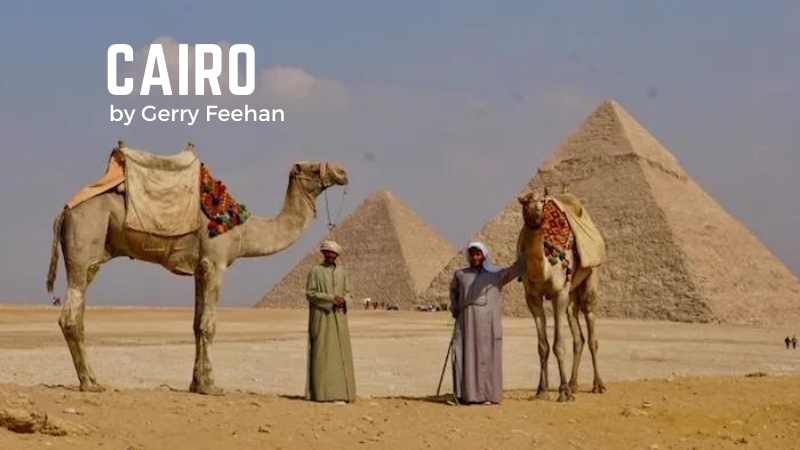
The Pyramids of Giza
The first thing one notices upon arrival in Egypt is the intense level of security. I was screened once, scanned twice and patted down thrice between the time we landed at the airport and when we finally stepped out into the muggy Cairo evening. At our hotel the scrutiny continued with one last investigation of our luggage in the lobby. Although Egyptian security is abundant in quantity, the quality is questionable. The airport x-ray fellow, examining the egg shaker in my ukulele case, sternly demanded, “This, this, open this.” When I innocently shook the little plastic thing to demonstrate its impermeability he recoiled in horror, but then observed it with fascination and called over his supervisor. Thus began an animated, impromptu percussion session. As for the ukulele, it was confiscated at hotel check-in and imprisoned in the coat check for the duration of our Cairo stay. The reasons proffered for the seizure of this innocuous little instrument ranged from “safety purposes” to “forbidden entertainment”. When, after a very long day, we finally collapsed exhausted into bed, I was shaken — but did not stir.
Al-Qahirah has 20 million inhabitants, all squeezed into a thin green strip along the Nile River. Fading infrastructure and an exponential growth in vehicles have contributed to its well-deserved reputation as one of the world’s most traffic-congested cities. The 20km trip from our hotel in the city center, to the Great Pyramid of Cheops at Giza across the river, took nearly two hours. The driver smiled, “Very good, not rush hour.”
Our entrance fee for the Giza site was prepaid but we elected to fork out the extra Egyptian pounds to gain access to the interior of the Great Pyramid. Despite the up-charge — and the narrow, dark, claustrophobic climb – the reward, standing in Cheop’s eternal resting place, a crypt hidden deep inside the pyramid, was well worth it. We also chose to stay after sunset, dine al fresco in the warm Egyptian evening, and watch the celebrated ‘sound and light’ performance. The show was good. The food was marginal. Our waiter’s name was Fahid. Like many devout Muslim men, he sported a zabiba, or prayer bump, a callus developed on the forehead from years of prostration. Unfortunately throughout the event Fahid hovered over us, attentive to the point of irritation, blocking our view of the spectacle while constantly snapping fingers at his nervous underlings. The ‘son et lumière’ show was a little corny, but it’s pretty cool to see a trio of 4500-year-old pyramids – and the adjoining Great Sphinx — illuminated by 21 st century technology.

The Great Sphinx

Giza at nightThe next night our group of six Canucks attended an Egyptian cooking class. Our ebullient hostess was Anhar, (‘the River’ in Arabic). Encouraged by her contagious enthusiasm, we whipped up a nice tabouli salad, spicy chicken orzo soup and eggplant moussaka. We finished up with homemade baklava. Throughout the evening, Anhar quizzed us about the ingredients, the herbs and spices, their origins and proper method of preparation. Anyone who answered correctly was rewarded with her approving nod and a polite clap. Soon a contest ensued. Incorrect answers resulted in a loud communal ‘bzzzt’ — like the sound ending a hockey game. It’s not polite to blow one’s own horn, but the Feehan contingent acquitted themselves quite nicely. If I still had her email, Anhar could confirm this.
Cairo was not the highlight of our three-week Egyptian holiday, but a visit to the capital is mandatory. First there’s the incredible Pyramids. But as well there’s the Egyptian Museum that houses the world’s largest collection of Pharaonic antiquities including the golden finery of King Tutankhamen and the mummified remains of Ramses the Great. Ramses’ hair is rust coloured and thinning a little, but overall he looks pretty good for a guy entering his 34 th century.

Ramses the Great

Then there’s Khan el-Khalili, the old souk or Islamic bazaar. We strolled its ancient streets and narrow meandering alleyways, continually set upon by indefatigable street hawkers. “La shukraan, no thanks,” we repeated ineffectually a thousand times. The souk’s cafes were jammed. A soccer match was on. The ‘beautiful game’ is huge in Egypt. Men and women sat, eyes glued to the screen, sipping tea and inhaling hubbly bubbly.

The Old Souk Bazaar

Selfies, Souk style
An aside. When traveling in Egypt, be sure to carry some loose change for the hammam (el baño for those of you who’ve been to Mexico). At every hotel, restaurant, museum and temple — even at the humblest rural commode — an attendant vigilantly guards the lavatory. And have small bills for the requisite baksheesh. You’re not getting change.
After our evening in the souk we had an early call. Our guide Sayed Mansour met us at 6am in the hotel lobby. “Yella, yella. Hurry, let’s go,” he said. “Ana mish bahasir – I’m not joking.” “Afwan,” we said. “No problem,” and jumped into the van. As we pulled away from the curb Sayed began the day’s tutorial, reciting a poem by Percy Blythe Shelly:
I met a traveller from an antique land,
Who said—“Two vast and trunkless legs of stone
Stand in the desert. . . . My name is Ozymandias, King of Kings;
Look on my Works, ye Mighty, and despair!”
And we were off, through the desert, to Alexandria. Founded by Alexander the Great in 332 BC, Egypt’s ancient capital was built on the Nile delta, where the world’s longest river meets the Mediterranean Sea. The day was a bit of a bust. The city was once renowned for its magnificent library and the famed Lighthouse of Alexandria. But the former burnt down shortly after Christ was born and the latter — one of the original seven wonders of the ancient world – toppled into the sea a thousand years ago. Absent some interesting architecture, a nice view of the sea from the Citadel — and Sayed’s entertaining commentary — Alexandria wasn’t really worth the long day trip. Besides, we needed to get back to Cairo and pack our swimwear. Sharm el Sheikh and the warm waters of the Red Sea were next up on the Egyptian agenda.

Gerry with some Egyptian admirers
Exodus Travel skilfully handled every detail of our trip: www.exodustravels.com And, if you’re thinking of visiting Egypt, I can suggest a nice itinerary. No sense reinventing the pyramid: [email protected]
Gerry Feehan is an award-winning travel writer and photographer. He lives in Kimberley, BC.

Thanks to Kennedy Wealth Management for sponsoring this series. Click on the ads and learn more about this long-term local business.
-

 National1 day ago
National1 day agoWar against the US? Chrystia Freeland says Canada, allies need to build ‘New World Order’ to combat Trump
-
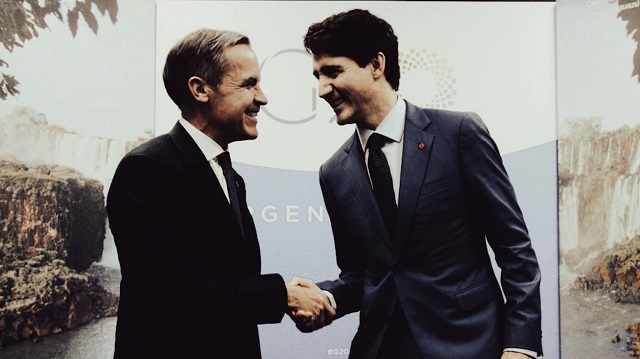
 Opinion1 day ago
Opinion1 day agoLiberal leadership race guarantees Canadian voters will be guided by a clown show for a while yet
-
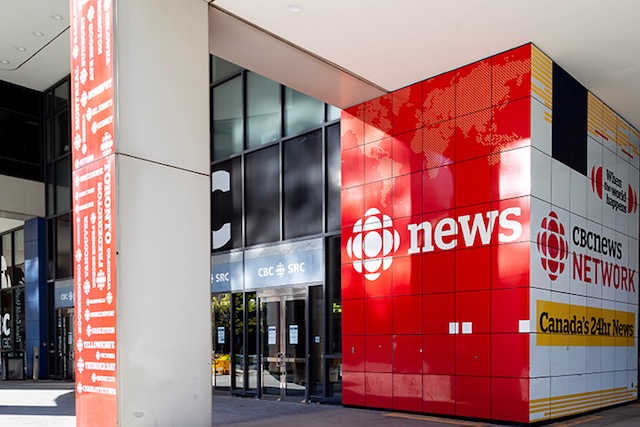
 Business1 day ago
Business1 day agoTaxpayers launching court fight against CBC transparency
-

 Business1 day ago
Business1 day agoElon Musk: ‘I’m getting a lot of death threats’ due to DOGE
-

 Crime1 day ago
Crime1 day agoCould the UK’s ‘Grooming Gangs’ operate in Canada?
-

 Alberta1 day ago
Alberta1 day agoAlberta Coordinating law enforcement to fight fentanyl
-

 Alberta1 day ago
Alberta1 day agoCan Trump Revive The Keystone Pipeline?
-
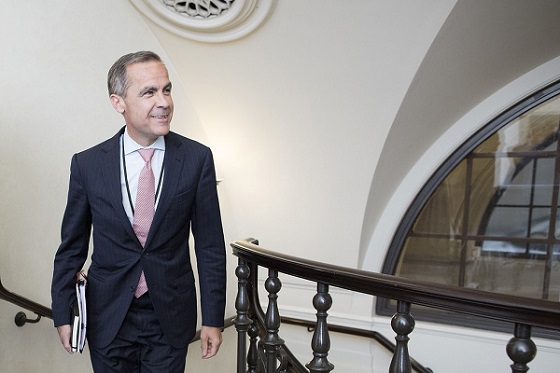
 Energy1 day ago
Energy1 day agoTrump’s tariffs made Ottawa suddenly start talking about new east-to-west pipelines, but how long will it last?

